Band Engineering of Photocatalytic BiVO4 with Modified Vanadium States via Potassium Chloride Addition during Hydro-Thermal Synthesis and Post-Annealing
Abstract
1. Introduction
2. Experimental
2.1. Materials
2.2. Preparation of BiVO4 Samples
2.3. Characterization
2.4. Photocatalysis Evaluation
3. Results and Discussion
3.1. Morphology
3.2. Crystal Structure
3.3. X-ray Photoelectron Spectroscope (XPS) Analysis
3.4. Optical Properties and Bandgap Analysis
3.5. Addition of KCl and Oxygen Vacancies
3.6. Photocatalytic Properties
4. Conclusions
Supplementary Materials
Author Contributions
Funding
Data Availability Statement
Acknowledgments
Conflicts of Interest
References
- Xi, G.; Ye, J. Synthesis of bismuth vanadate nanoplates with exposed {001} facets and enhanced visible-light photocatalytic properties. Chem. Commun. 2010, 46, 1893–1895. [Google Scholar] [CrossRef]
- Senasu, T.; Youngme, S.; Hemavibool, K.; Nanan, S. Sunlight-driven photodegradation of oxytetracycline antibiotic by BiVO4 photocatalyst. J. Solid State Chem. 2021, 297, 122088. [Google Scholar] [CrossRef]
- Inoue, T.; Fujishima, A.; Konishi, S.; Honda, K. Photoelectrocatalytic reduction of carbon dioxide in aqueous suspensions of semiconductor. Nature 1979, 277, 637. [Google Scholar] [CrossRef]
- Banerjee, S.; Dionysiou, D.D.; Pillai, S.C. Self-cleaning applications of TiO2 by photo-induced hydrophilicity and photocatalysis. Appl. Catal. B Environ. 2015, 176–177, 396–428. [Google Scholar] [CrossRef]
- Dette, C.; Pérez-Osorio, M.A.; Kley, C.S.; Punke, P.; Patrick, C.E.; Jacobson, P.; Giustino, F.; Jung, S.J.; Kern, K. TiO2 anatase with a bandgap in the visible region. Nano Lett. 2014, 14, 6533–6538. [Google Scholar] [CrossRef] [PubMed]
- Qin, W.; Zhang, D.; Zhao, D.; Wang, L.; Zheng, K. Near-infrared photocatalysis based on YF3:Yb3+, Tm3+/TiO2 core/shell nanoparticles. Chem. Commun. 2010, 46, 2304–2306. [Google Scholar] [CrossRef] [PubMed]
- Wang, Z.; Mao, X.; Chen, P.; Xiao, M.; Monny, S.A.; Wang, S.; Konarova, M.; Du, A.; Wang, L. Understanding the roles of oxygen vacancies in hematite-based photoelectrochemical processes. Angew. Chem. Int. Ed. 2019, 58, 1030–1034. [Google Scholar] [CrossRef] [PubMed]
- Zhang, Z.; Shao, C.; Li, X.; Sun, Y.; Zhang, M.; Mu, J.; Zhang, P.; Guo, Z.; Liu, Y. Hierarchical assembly of ultrathin hexagonal SnS2 nanosheets onto electrospun TiO2 nanofibers: Enhanced photocatalytic activity based on photoinduced interfacial charge transfer. Nanoscale 2013, 5, 606–618. [Google Scholar] [CrossRef]
- Hao, X.; Hu, Y.; Cui, Z.; Zhou, J.; Wang, Y.; Zou, Z. Self-constructed facet junctions on hexagonal CdS single crystals with high photoactivity and photostability for water splitting. Appl. Catal. B Environ. 2019, 244, 694–703. [Google Scholar] [CrossRef]
- Zhao, G.; Liu, W.; Hao, Y.; Zhang, Z.; Li, Q.; Zang, S. Nanostructured shuriken-like BiVO4 with preferentially exposed {010} facets: Preparation, formation mechanism, and enhanced photocatalytic performance. Dalton Trans. 2018, 47, 1325–1336. [Google Scholar] [CrossRef]
- Tan, H.L.; Amal, R.; Ng, Y.H. Alternative strategies in improving the photocatalytic and photoelectrochemical activities of visible light-driven BiVO4: A review. J. Mater. Chem. A 2017, 5, 16498–16521. [Google Scholar] [CrossRef]
- Cooper, J.K.; Scott, S.B.; Ling, Y.; Yang, J.; Hao, S.; Li, Y.; Toma, F.M.; Stutzmann, M.; Lakshmi, K.V.; Sharp, I.D. Role of hydrogen in defining the n-type character of BiVO4 photoanodes. Chem. Mater. 2016, 28, 5761–5771. [Google Scholar] [CrossRef]
- Kim, T.W.; Ping, Y.; Galli, G.A.; Choi, K.-S. Simultaneous enhancements in photon absorption and charge transport of bismuth vanadate photoanodes for solar water splitting. Nat. Commun. 2015, 6, 8769. [Google Scholar] [CrossRef] [PubMed]
- Tan, H.L.; Suyanto, A.; De Denko, A.T.; Saputera, W.H.; Amal, R.; Osterloh, F.E.; Ng, Y.H. Enhancing the photoactivity of faceted BiVO4 via annealing in oxygen-deficient condition. Part. Part. Syst. Charact. 2017, 34, 1600290. [Google Scholar] [CrossRef]
- Qin, C.; Liao, H.; Rao, F.; Zhong, J.; Li, J. One-pot hydrothermal preparation of Br-doped BiVO4 with enhanced visible-light photocatalytic activity. Solid State Sci. 2020, 105, 106285. [Google Scholar] [CrossRef]
- Liu, H.; Zeng, F.; Lin, Y.; Wang, G.; Pan, F. Correlation of oxygen vacancy variations to band gap changes in epitaxial ZnO thin films. Appl. Phys. Lett. 2013, 102, 181908. [Google Scholar] [CrossRef]
- Biswas, R.U.D.; Oh, W.-C. Synthesis of BiVO4-GO-PVDF nanocomposite: An excellent, newly designed material for high photocatalytic activity towards organic dye degradation by tuning band gap energies. Solid State Sci. 2018, 80, 22–30. [Google Scholar] [CrossRef]
- Meng, S.; Ogawa, T.; Okumura, H.; Ishihara, K.N. The effect of potassium chloride on BiVO4 morphology and photocatalysis. J. Solid State Chem. 2021, 302, 122291. [Google Scholar] [CrossRef]
- Künneth, C.; Batra, R.; Rossetti, G.A.; Ramprasad, R.; Kersch, A. Thermodynamics of phase stability and ferroelectricity from first principles. In Ferroelectricity in Doped Hafnium Oxide: Materials, Properties and Devices; Woodhead Publishing: Sawston, UK, 2019. [Google Scholar] [CrossRef]
- Gunkel, F.; Christensen, D.V.; Chen, Y.Z.; Pryds, N. Oxygen vacancies: The (in)visible friend of oxide electronics. Appl. Phys. Lett. 2020, 116, 120505. [Google Scholar] [CrossRef]
- Wang, S.; He, T.; Chen, P.; Du, A.; Ostrikov, K.; Huang, W.; Wang, L. In situ formation of oxygen vacancies achieving near-complete charge separation in planar BiVO4 photoanodes. Adv. Mater. 2020, 32, 2001385. [Google Scholar] [CrossRef]
- Yu, W.; Chen, F.; Wang, Y.; Zhao, L. Rapid evaluation of oxygen vacancies-enhanced photogeneration of the superoxide radical in nano-TiO2 suspensions. RSC Adv. 2020, 10, 29082–29089. [Google Scholar] [CrossRef] [PubMed]
- Yamada, K.; Yamane, H.; Matsushima, S.; Nakamura, H.; Ohira, K.; Kouya, M.; Kumada, K. Effect of thermal treatment on photocatalytic activity of N-doped TiO2 particles under visible light. Thin Solid Films 2008, 516, 7482–7487. [Google Scholar] [CrossRef]
- Wang, G.; Ling, Y.; Lu, X.; Qian, F.; Tong, Y.; Zhang, J.Z.; Lordi, V.; Leao, C.R.; Li, Y. Computational and photoelectrochemical study of hydrogenated bismuth vanadate. J. Phys. Chem. C 2013, 117, 10957–10964. [Google Scholar] [CrossRef]
- Li, Y.; Yang, B.; Liu, B. Synthesis of BiVO4 nanoparticles with tunable oxygen vacancy level: The phenomena and mechanism for their enhanced photocatalytic performance. Ceram. Int. 2021, 47, 9849–9855. [Google Scholar] [CrossRef]
- Wang, G.; Wang, H.; Ling, Y.; Tang, Y.; Yang, X.; Fitzmorris, R.C.; Wang, C.; Zhang, J.Z.; Li, Y. Hydrogen-treated TiO2 nanowire arrays for photoelectrochemical water splitting. Nano Lett. 2011, 11, 3026–3033. [Google Scholar] [CrossRef]
- Mtangi, W.; Auret, F.D.; Meyer, W.E.; Legodi, M.J.; Janse Van Rensburg, P.J.; Coelho, S.M.M.; Diale, M.; Nel, J.M. Effects of hydrogen, oxygen, and argon annealing on the electrical properties of ZnO and ZnO devices studied by current-voltage, deep level transient spectroscopy, and Laplace DLTS. J. Appl. Phys. 2012, 111, 094504. [Google Scholar] [CrossRef]
- Zhang, T.; Liu, Y.; Jiang, S.; Li, B.; Wang, J.; Shao, X.; Wang, D.; Wang, K.; Yan, Z. Bacitracin-assisted synthesis of spherical BiVO4 nanoparticles with C doping for remarkable photocatalytic performance under visible light. CrystEngComm 2020, 22, 1812–1821. [Google Scholar] [CrossRef]
- Ravidhas, C.; Josephine, A.J.; Sudhagar, P.; Devadoss, A.; Terashima, C.; Nakata, K.; Fujishima, A.; Raj, A.M.E.; Sanjeeviraja, C. Facile synthesis of nanostructured monoclinic bismuth vanadate by a co-precipitation method: Structural, optical and photocatalytic properties. Mater. Sci. Semicond. Process. 2015, 30, 343–351. [Google Scholar] [CrossRef]
- Xie, S.; Shen, Z.; Zhang, H.; Cheng, J.; Zhang, Q.; Wang, Y. Photocatalytic coupling of formaldehyde to ethylene glycol and glycolaldehyde over bismuth vanadate with controllable facets and cocatalysts. Catal. Sci. Technol. 2017, 7, 923–933. [Google Scholar] [CrossRef]
- Liu, X.; Su, Y.; Zhao, Q.; Du, C.; Liu, Z. Constructing Bi24O31Cl10/BiOCl heterojunction via a simple thermal annealing route for achieving enhanced photocatalytic activity and selectivity. Sci. Rep. 2016, 6, 28689. [Google Scholar] [CrossRef]
- Eggenweiler, U.; Keller, E.; Krämer, V. Redetermination of the crystal structures of the “arppe compound” Bi24O31Cl10 and the isomorphous Bi24O31Br10. Acta Crystallogr. Sect. B Struct. Sci. 2000, 56, 431–437. [Google Scholar] [CrossRef] [PubMed]
- Cui, P.; Wang, J.; Wang, Z.; Chen, J.; Xing, X.; Wang, L.; Yu, R. Bismuth oxychloride hollow microspheres with high visible light photocatalytic activity. Nano Res. 2016, 9, 593–601. [Google Scholar] [CrossRef]
- Sorokina, S.; Enjalbert, R.; Baulès, P.; Castro, A.; Galy, J. Continuous structural evolution of (Bi2O2)2V2yO4y+2(1≤y≤4) aurivillius phases in the Bi2O3–VO2 system. J. Solid State Chem. 1996, 125, 54–62. [Google Scholar] [CrossRef]
- Galy, J.; Enjalbert, R.; Millan, P.; Castro, A. New Aurivillius phases in the bismuth-vanadium-oxygen system crystal structure of Bi4V2O10. Comptes Rendus l’Academie Des Sci. Ser. 2 1993, 317, 43–48. Available online: http://inis.iaea.org/search/search.aspx?orig_q=RN:24068739 (accessed on 14 June 2022). [CrossRef]
- Satto, C.; Millet, P.; Sciau, P.; Roucau, C.; Galy, J. α-Bi4V2O10 crystal structure and oxidation mechanism. X-ray and electron diffraction analysis. Mater. Res. Bull. 1999, 34, 655–664. [Google Scholar] [CrossRef]
- Yuan, Y.; Huang, Y.; Ma, F.; Zhang, Z.; Wei, X. Effects of oxygen vacancy on the mechanical, electronic and optical properties of monoclinic BiVO4. J. Mater. Sci. 2017, 52, 8546–8555. [Google Scholar] [CrossRef]
- Selim, S.; Pastor, E.; García-Tecedor, M.; Morris, M.R.; Francàs, L.; Sachs, M.; Moss, B.; Corby, S.; Mesa, C.A.; Gimenez, S.; et al. Impact of oxygen vacancy occupancy on charge carrier dynamics in BiVO4 photoanodes. J. Am. Chem. Soc. 2019, 141, 18791–18798. [Google Scholar] [CrossRef] [PubMed]
- Ma, D.-K.; Guan, M.-L.; Liu, S.-S.; Zhang, Y.-Q.; Zhang, C.-W.; He, Y.-X.; Huang, S.-M. Controlled synthesis of olive-shaped Bi2S3/BiVO4 microspheres through a limited chemical conversion route and enhanced visible-light-responding photocatalytic activity. Dalton Trans. 2012, 41, 5581–5586. [Google Scholar] [CrossRef]
- Feng, C.; Wang, D.; Jin, B.; Jiao, Z. The enhanced photocatalytic properties of BiOCl/BiVO4 p-n heterojunctions via plasmon resonance of metal Bi. RSC Adv. 2015, 5, 75947–75952. [Google Scholar] [CrossRef]
- Jaihindh, D.P.; Thirumalraj, B.; Chen, S.-M.; Balasubramanian, P.; Fu, Y.-P. Facile synthesis of hierarchically nanostructured bismuth vanadate: An efficient photocatalyst for degradation and detection of hexavalent chromium. J. Hazard. Mater. 2019, 367, 647–657. [Google Scholar] [CrossRef]
- Jiang, H.; Dai, H.; Meng, X.; Ji, K.; Zhang, L.; Deng, J. Porous olive-like BiVO4: Alcoho-hydrothermal preparation and excellent visible-light-driven photocatalytic performance for the degradation of phenol. Appl. Catal. B 2011, 105, 326–334. [Google Scholar] [CrossRef]
- Sun, S.; Wang, W.; Zhou, L.; Xu, H. Efficient methylene blue removal over hydrothermally synthesized starlike BiVO4. Ind. Eng. Chem. Res. 2009, 48, 1735–1739. [Google Scholar] [CrossRef]
- Cao, J.; Zhou, C.; Lin, H.; Xu, B.; Chen, S. Surface modification of m-BiVO4 with wide band-gap semiconductor BiOCl to largely improve the visible light induced photocatalytic activity. Appl. Surf. Sci. 2013, 284, 263–269. [Google Scholar] [CrossRef]
- Qin, D.-D.; Wang, T.; Song, Y.-M.; Tao, C.-L. Reduced monoclinic BiVO4 for improved photoelectrochemical oxidation of water under visible light. Dalton Trans. 2014, 43, 7691–7694. [Google Scholar] [CrossRef] [PubMed]
- Okumura, H.; Adachi, K.; Yamasue, E.; Ishihara, K.N. New LnOCl (Ln = Sm, Nd) photocatalyst and novel cocatalytic effect on BiOCl in humid environment. Chem. Commun. 2017, 53, 8854–8857. [Google Scholar] [CrossRef]
- Cheng, C.; Fang, Q.; Fernandez-Alberti, S.; Long, R. Controlling charge carrier trapping and recombination in BiVO4 with the oxygen vacancy oxidation state. J. Phys. Chem. Lett. 2021, 12, 3514–3521. [Google Scholar] [CrossRef] [PubMed]
- Wang, Q.; Zhang, S.; He, H.; Xie, C.; Tang, Y.; He, C.; Shao, M.; Wang, H. Oxygen vacancy engineering in titanium dioxide for sodium storage. Chem. Asian J. 2021, 16, 3–19. [Google Scholar] [CrossRef]
- Byun, S.; Jung, G.; Shi, Y.; Lanza, M.; Shin, B. Aging of a vanadium precursor solution: Influencing material properties and photoelectrochemical water oxidation performance of solution-processed BiVO4 photoanodes. Adv. Funct. Mater. 2020, 30, 1806662. [Google Scholar] [CrossRef]
- Kim, S.; Vijayakumar, M.; Wang, W.; Zhang, J.; Chen, B.; Nie, Z.; Chen, F.; Hu, J.; Li, L.; Yang, Z. Chloride supporting electrolytes for all-vanadium redox flow batteries. Phys. Chem. Chem. Phys. 2011, 13, 18186–18193. [Google Scholar] [CrossRef]
- He, Z.; Shi, Y.; Gao, C.; Wen, L.; Chen, J.; Song, S. BiOCl/BiVO4 p–n heterojunction with enhanced photocatalytic activity under visible-light irradiation. J. Phys. Chem. C 2014, 118, 389–398. [Google Scholar] [CrossRef]
- Wagman, D.; Evans, W.; Parker, V.; Schumm, R.; Halow, I.; Bailey, S.; Churney, K.; Nuttall, R. Erratum: The NBS tables of chemical thermodynamic properties. Selected values for inorganic and C1 and C2 organic substances in SI units. Phys. Chem. Ref. Data 11, Suppl. 2 (1982)]. J. Phys. Chem. Ref. Data 1989, 18, 1807–1812. [Google Scholar] [CrossRef]

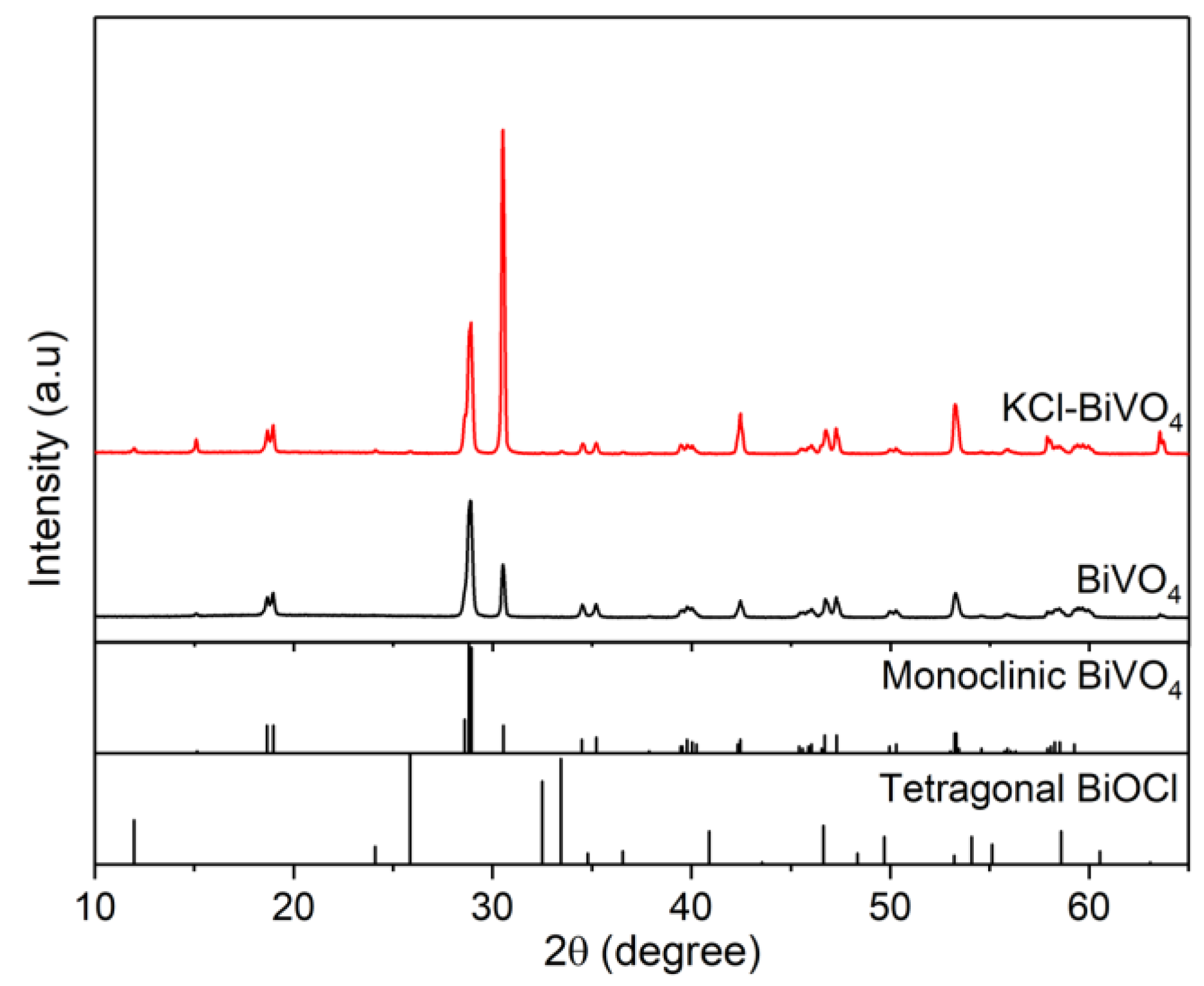
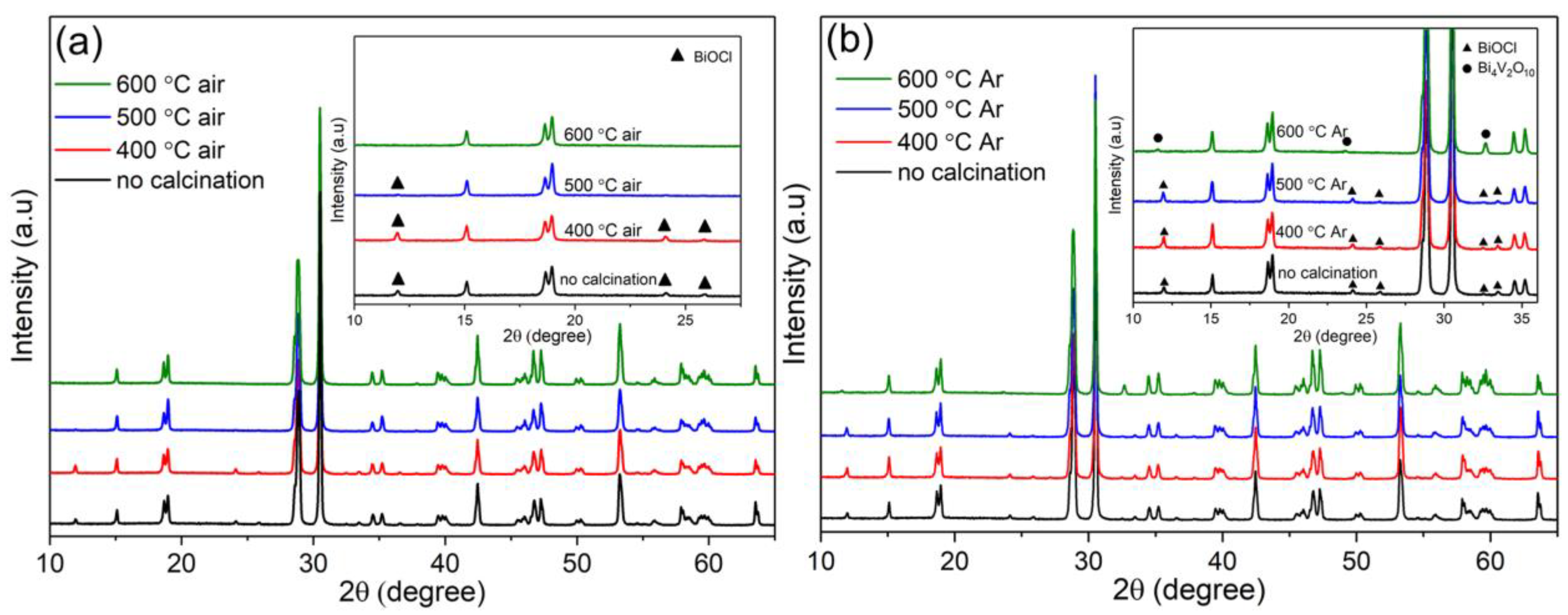
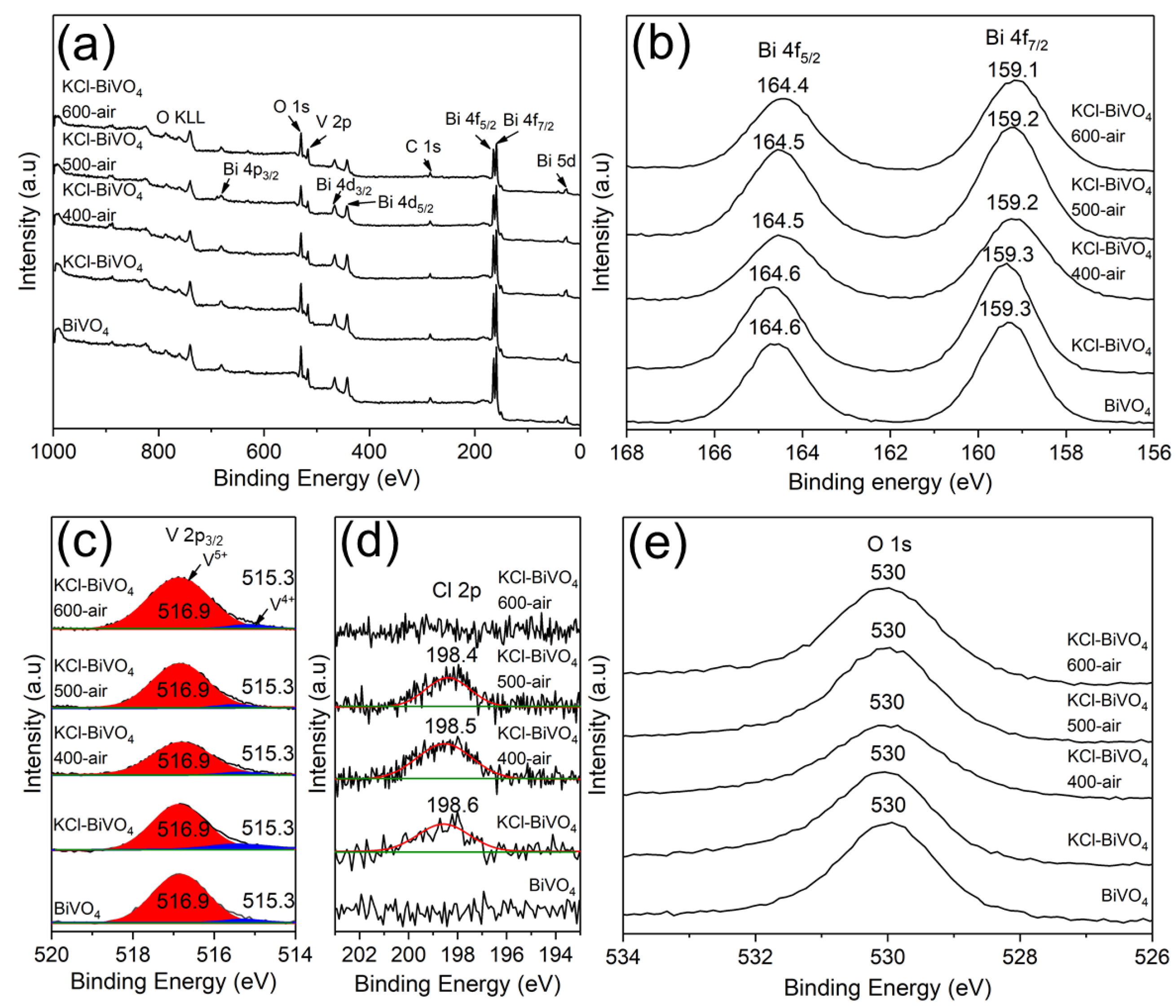
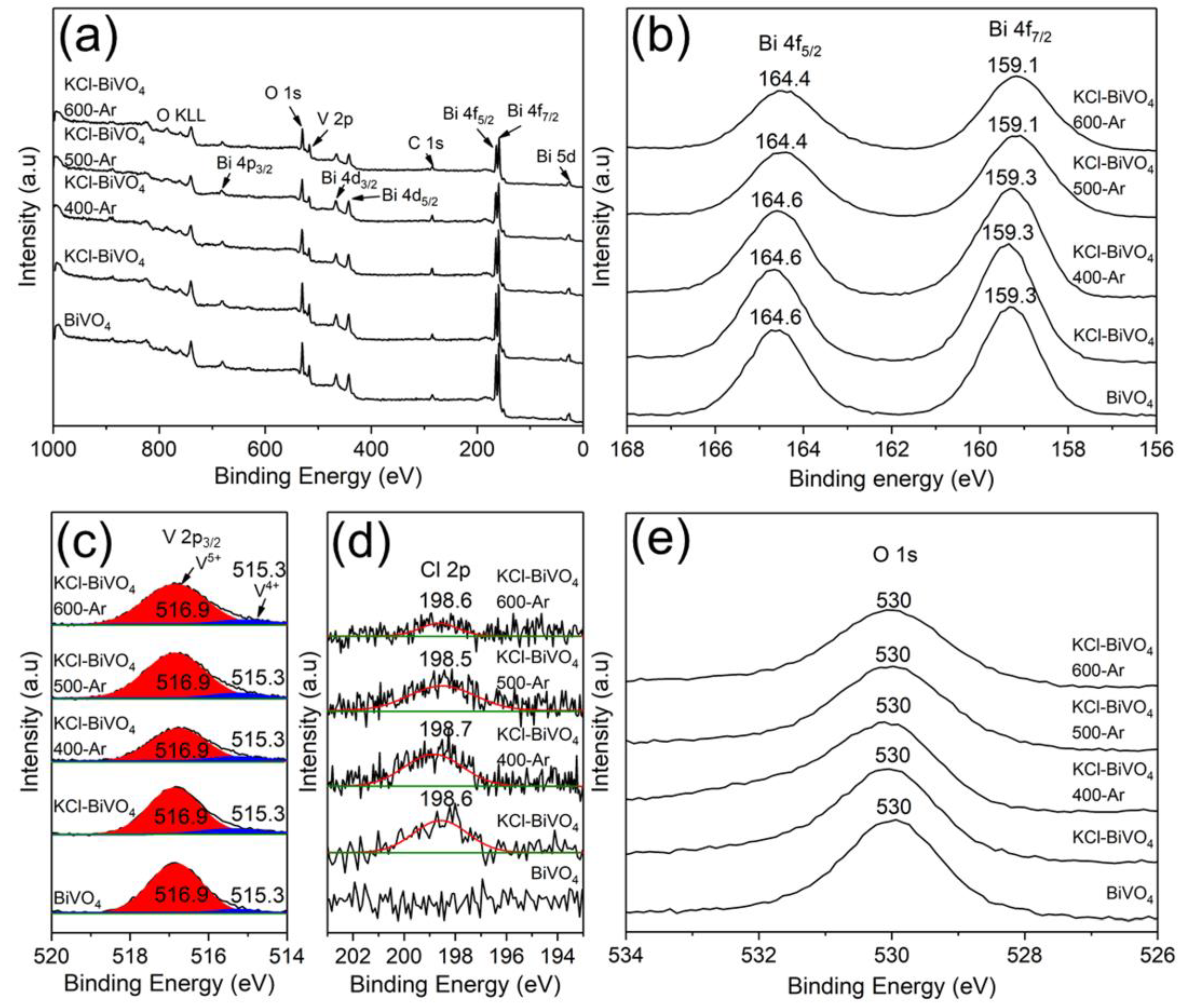
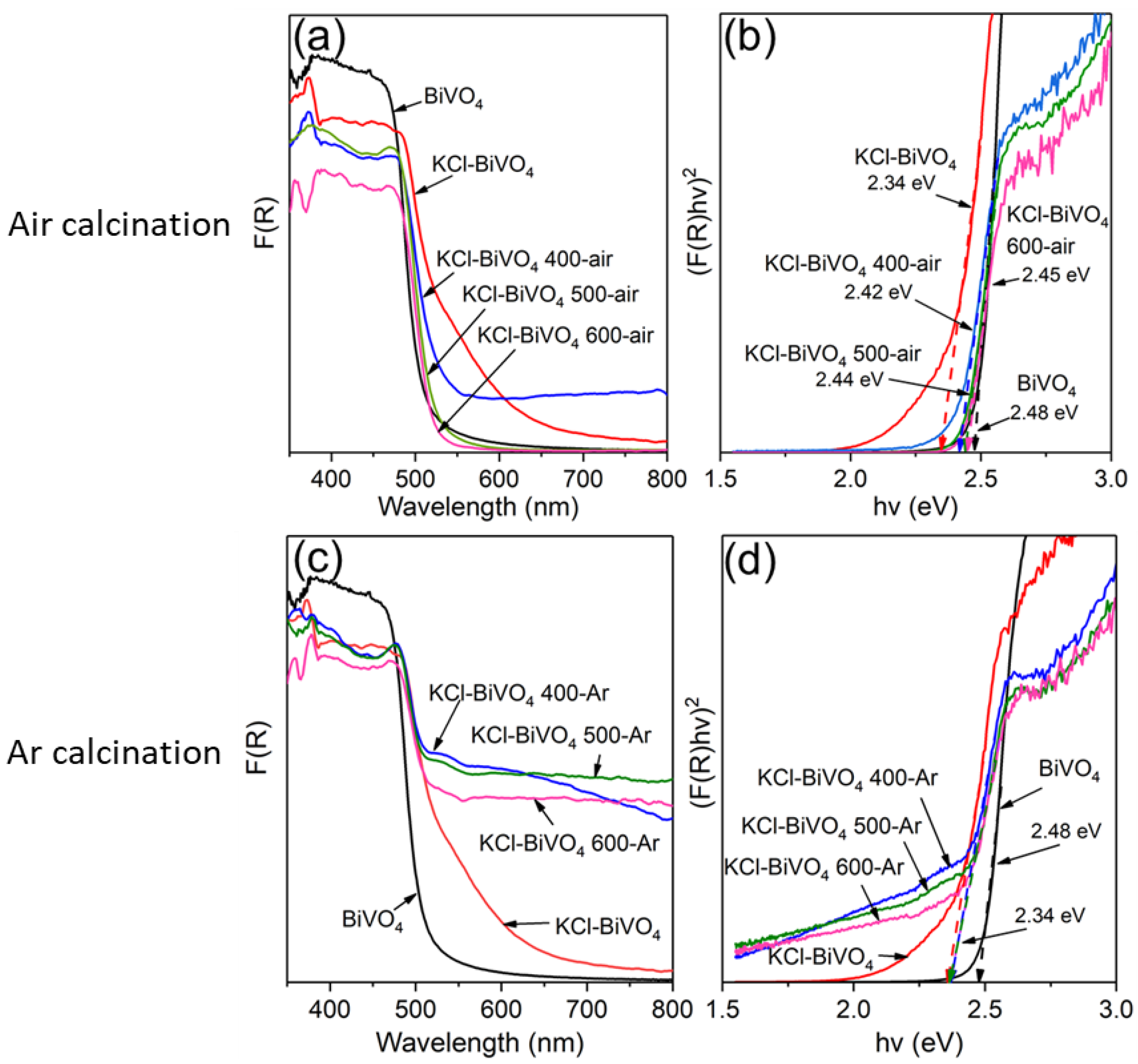
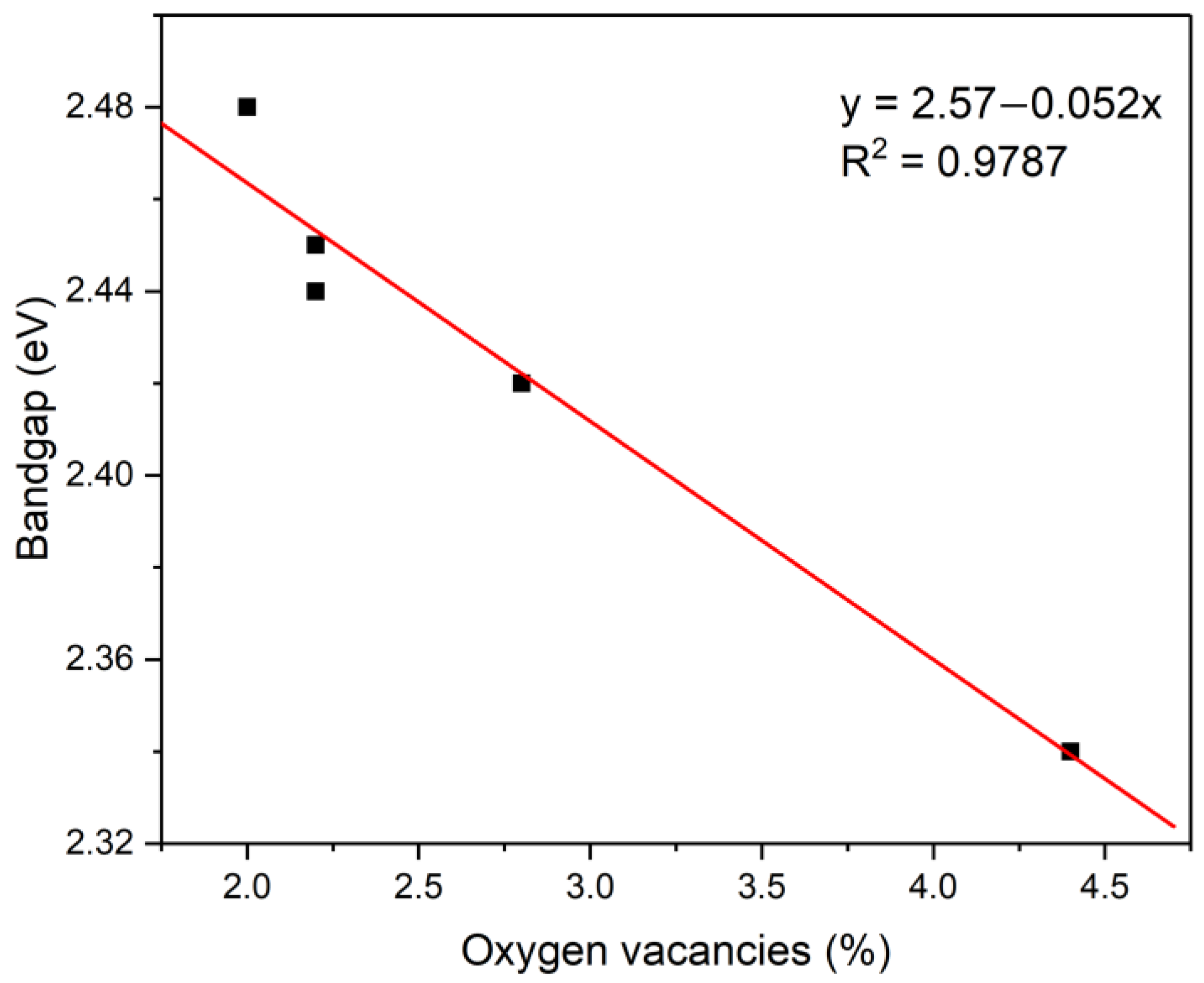
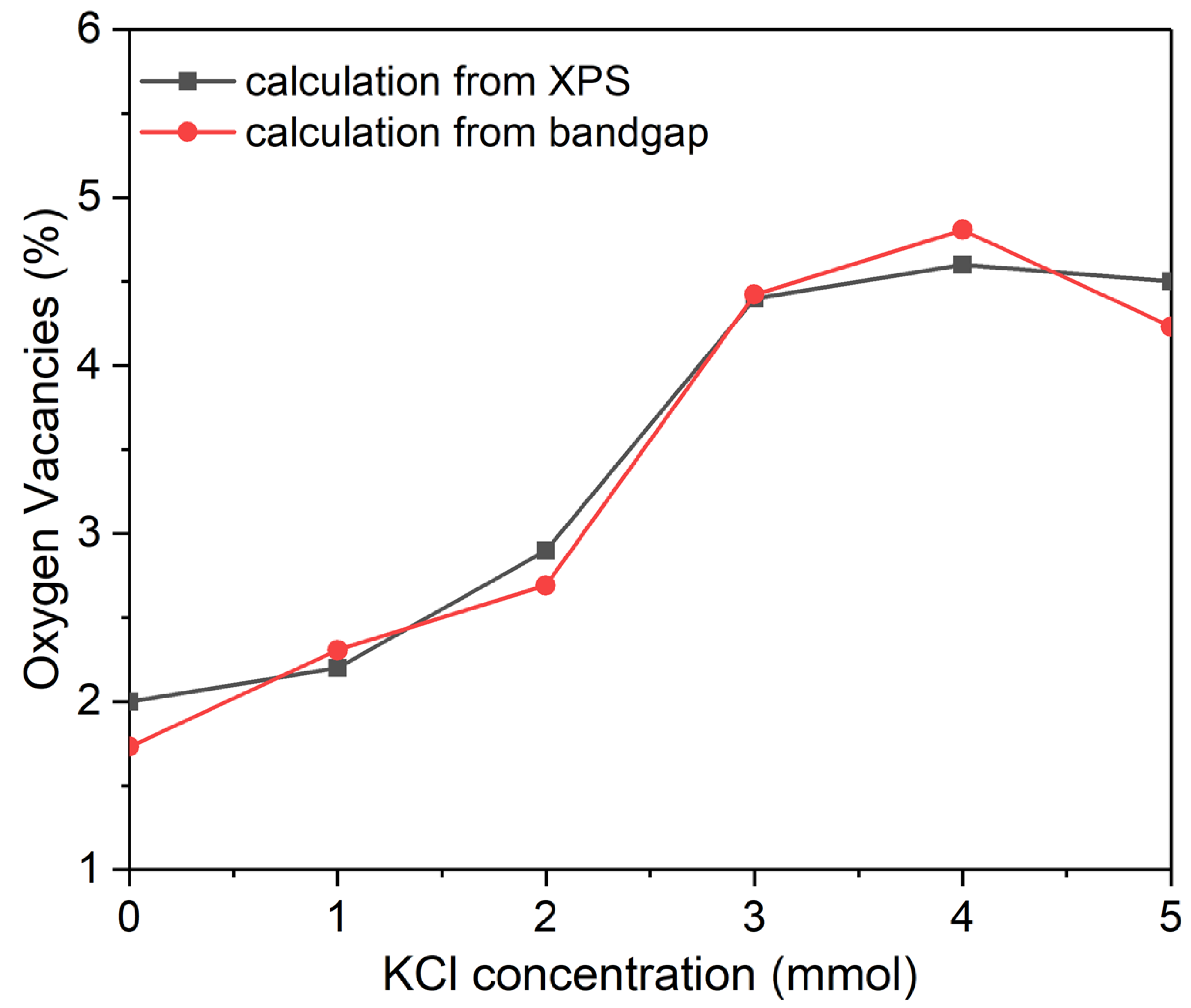

| Sample | Peak Area V5+ (%) | Peak Area V4+ (%) | % Oxygen Vacancy, Vo (%) | Bandgap, Eg (eV) |
|---|---|---|---|---|
| KCl-BiVO4 | 91.2 | 8.8 | 4.4 | 2.34 |
| KCl-BiVO4 400-Ar | 91.2 | 8.8 | 4.4 | 2.34 |
| KCl-BiVO4 500-Ar | 91.2 | 8.8 | 4.4 | 2.34 |
| KCl-BiVO4 600-Ar | 90.8 | 9.2 | —a | 2.34 |
| KCl-BiVO4 400-air | 94.4 | 5.6 | 2.8 | 2.42 |
| KCl-BiVO4 500-air | 95.5 | 4.5 | 2.2 | 2.44 |
| KCl-BiVO4 600-air | 95.7 | 4.3 | 2.2 | 2.45 |
| BiVO4 | 96.1 | 3.9 | 2.0 | 2.48 |
Disclaimer/Publisher’s Note: The statements, opinions and data contained in all publications are solely those of the individual author(s) and contributor(s) and not of MDPI and/or the editor(s). MDPI and/or the editor(s) disclaim responsibility for any injury to people or property resulting from any ideas, methods, instructions or products referred to in the content. |
© 2023 by the authors. Licensee MDPI, Basel, Switzerland. This article is an open access article distributed under the terms and conditions of the Creative Commons Attribution (CC BY) license (https://creativecommons.org/licenses/by/4.0/).
Share and Cite
Meng, S.; Ogawa, T.; Ishihara, K.N.; Okumura, H. Band Engineering of Photocatalytic BiVO4 with Modified Vanadium States via Potassium Chloride Addition during Hydro-Thermal Synthesis and Post-Annealing. Energies 2023, 16, 629. https://doi.org/10.3390/en16020629
Meng S, Ogawa T, Ishihara KN, Okumura H. Band Engineering of Photocatalytic BiVO4 with Modified Vanadium States via Potassium Chloride Addition during Hydro-Thermal Synthesis and Post-Annealing. Energies. 2023; 16(2):629. https://doi.org/10.3390/en16020629
Chicago/Turabian StyleMeng, Sopheak, Takaya Ogawa, Keiichi N. Ishihara, and Hideyuki Okumura. 2023. "Band Engineering of Photocatalytic BiVO4 with Modified Vanadium States via Potassium Chloride Addition during Hydro-Thermal Synthesis and Post-Annealing" Energies 16, no. 2: 629. https://doi.org/10.3390/en16020629
APA StyleMeng, S., Ogawa, T., Ishihara, K. N., & Okumura, H. (2023). Band Engineering of Photocatalytic BiVO4 with Modified Vanadium States via Potassium Chloride Addition during Hydro-Thermal Synthesis and Post-Annealing. Energies, 16(2), 629. https://doi.org/10.3390/en16020629







